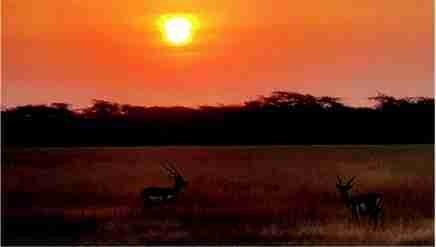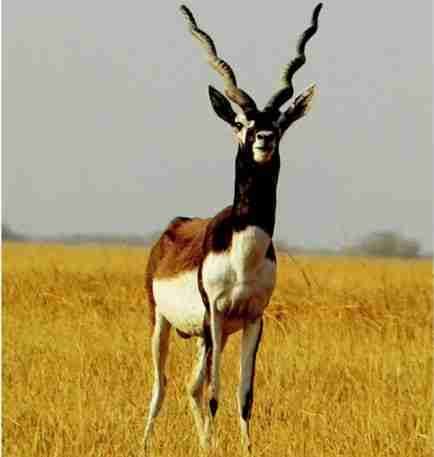Did you know about the Black Bucks and the Indian Savannah? Did you know about the Black Bucks and the Indian Savannah?
We visited the mesmerising and well populated Velavdar Black Buck National Park in three different months and each time we were surprised by a new kind of sighting. At one time there were hundreds of black bucks all around, at another we got epic sightings of the vulpine family and the third time we arrived during the migration season and the sky had to be seen to be believed. Thousands of migratory birds circled all over the sky around us. Felt so good to know such natural habitats still exist where birds and animals can thrive, away from all kinds of pollution, untouched by the ‘advanced’ city life.

The National Park is situated in the Bhavnagar District of Gujarat. The entry fee is nominal and our well informed local guide Amit Kanu Bahi Vegad took charge of the safari immediately. He told us that the Black Buck and Neel Gai are today, signature antelopes of the park, which will always be seen (as the population is so dense), but just a few years ago, things were not looking that good. The property initially belonged to the Raja, Krishna Kumar who gave it to the government of India. The government declared the region a Black Buck Sanctuary in 1966 but that didn’t protect the dwindling Black Buck population, which was subject to hunting and disease, and the area was open to grazing for all. A year later, in 1967, just about 200 Black Buck remained. In 1976, it was declared a National Park and things have been looking up ever since. According to the last census, the Black Buck population is now about 5000 and only half of it is in the National Park. The rest of them have been sighted in and around forty villages surrounding the National Park. This is the highest presence of said mammal at any one region in India.

The humble Velavdar park boasts of the highest number of Harrier sightings across the world and is a major attraction for photographers! Another popular pull for conservationists are the Indian Grey Wolf and the Hyena which have joined the Lion in the critical indigenous species list. Their populations are dwindling across the country and this National Park is their last hope. Other mammals sighted here are the wolf, hyena, jackal, fox, jungle cat, wild boar, Indian hare and the Indian mongoose. Among our three different safaris we managed to sight all of them!

The landscape of the region is remarkably similar to the African grasslands and hence it is called the Indian Savannah. When the Black Bucks sit down in the tall grass, all that one can spot from a distance are their gorgeous horns! The only tree that thrives in the salty lands of the region is the Babul. The Desi Babul is the one that is aesthetic and photogenic. But the Gaanda (meaning crazy) Babul is the one that is all over the place. It looks unkempt, grows in any direction and appears more like an overgrown bush than a tree. But it is this tree that the Black Buck and the birds love. They eat its seeds, and those that do not get digested, come out in the droppings, sprouting more trees. Bhavnager provides the ideal habitat for Black Bucks with the Babul trees, the vast grasslands and salty grounds (which they lick to assist in digestion).
The park stays closed from 15th June to 15th October. The best time to visit is from October when it opens to January.

The migratory birds are there in plenty and over 120 species of birds have been sighted here. Summers are brutal. But since Safaris are held early mornings and post lunch, one can manage the Safari out in the open. The natural water bodies dry up at this time and the manmade cement ponds are routinely filled up by water tankers. Jeeps are recommended so that one can cover maximum area. But one must step down and walk a bit as well, to complete the experience.
The government guesthouse, the Kaliyar Bhawan is not just reasonable but also clean and well maintained. Bookings must be made in advance. One can book guides, who sit in waiting, at the park’s ticket counter. The National Park must definitely be on one’s bucket list, especially if one is a wildlife enthusiast. After having lived in Africa for over a year and going for numerous safaris there, I can say with confidence that this Park, the game sighting here and the overall experience is world class and unique.
Vadodara based writer, Aarti K. Pathak is former CEO of a web portal. She writes on various subjects from family, relationships and parenting to her favourite one, her discoveries of India. She blogs at sparrowtimes.wordpress.com.


